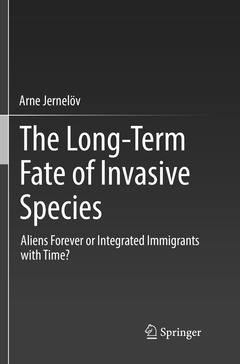The Long-Term Fate of Invasive Species, 1st ed. 2017 Aliens Forever or Integrated Immigrants with Time?
Langue : Anglais
Auteur : Jernelöv Arne

This book examines the long-term fate of invasive species by detailing examples of invaders from different zoological and botanical taxa from various places around the world. Readers will discover what happened, after a century or so, to 'classical' invaders like rabbits in Australia, house sparrows in North America, minks in Europe and water hyacinths in Africa and Asia.
Chapters presented in the book focus on eighteen species in the form of in-depth case studies including: earthworms, zebra mussels, Canadian water weed, Himalayan balsam, house sparrows, rabbits, crayfish plague, Colorado beetles, water hyacinths, starlings, Argentine ant, Dutch elm disease, American mink, cane toad, raccoons, Canadian beavers, African killer bees and warty comb jelly. Invaded areas described are in Africa, Asia, Australia, Europe, North America, Pacific islands, and South America. Readers will get some ideas about the likely future of current invaders from the fate of old ones. This book is intended for undergraduates studying environmental sciences, researchers and members of environmental NGO's.
Earthworms in North America.- Zebra mussels in Western Europe and North America.- Canadian water weed in Europe.- Himalayan balsam in Europe.- House sparrows in North America.- Rabbits in Australia.- Crayfish plague in Europe.- Colorado (potato) beetle.- Water hyacinths in Africa and Asia.- Starlings in North America.- Argentine ant on Mediterranean shores.- Dutch elm disease in Europe and North America.- American mink in Europe Marine (cane) toad on Pacific islands.- Raccoons in Europe.- Canadian beaver on Tierra del Fuego.- African “killer bees” in the Americas.- Warty comb jelly in the Black Sea.- Some concluding remarks emanating from the case studies.- Index.
Dr. Arne Jernelöv is a Swedish biologist and environmental scientist. He has served as Director of the International Institute for Applied Systems Analysis (IIASA) in Vienna, Austria. Prior to that he was Director and Professor of the Environmental and Space Research Institute in Kiruna, Sweden.
Covers a wide range of invasive species to detail the global extent of invasive impacts; Takes a long-term perspective on invasive species to discuss trends and future environmental and economic effects; Educates readers about one of the most topical contemporary environmental issues to inspire future action and research. Includes supplementary material: sn.pub/extras
Date de parution : 08-2018
Ouvrage de 296 p.
15.5x23.5 cm
Date de parution : 05-2017
Ouvrage de 296 p.
15.5x23.5 cm
Thèmes de The Long-Term Fate of Invasive Species :
© 2024 LAVOISIER S.A.S.



